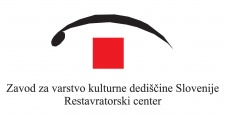Restoration Centre, Institute for the Protection of Cultural Heritage of Slovenia (ZVKDS)
History
The beginnings of organised restoration activities date back to 1950, when a restoration department within the then Institute for the Protection and Scientific Study of Cultural Monuments and Natural Heritage of Slovenia was organised.
In 1982 the restoration department separated from the newly renamed institute as an independent institution. In 1999 the Restoration Centre once again became a part of the larger institute.
Since 2008, after the reorganisation of the Institute for the Protection of Cultural Heritage of Slovenia, the Restoration Centre operates under the Conservation Centre, one of two main units of the institute.
Departments and activities
The The Restoration Centre consists of seven departments: Project planning department, Department for natural science research, Department for classic canvas painting, Department for murals and mosaics, Department for wood, Department for stone and stuccowork, Department for metals, ceramics and other materials and the Documentation department.
The Centre takes care for the development and the direction of the conservation-restoration and restoration profession in Slovenia. The centre leads and runs preliminary research work on monuments, prepares conservation plans for monuments owned by the state, carries out conservation and restoration projects for most complex interventions as well as on highly important monuments. It cooperates with other institutions and government departments and develops public awareness of conservation and restoration activities.
The Restoration Centre works according to appropriate criteria and methods, using the latest heritage technology (for example, laser cleaning, copying, anoxy method, stone non-destructive research).
Educational and exhibition activities
The Restoration Centre also engages in educational activities for professionals as well as for secondary school and university students and the broader public. The Restoration Centre also prepares exhibitions.
Documentation and library
The Documentation Department and the Library maintain two collections, consisting mainly of publications and documents: the "library collection" houses thousands of inventory items, related to conservation-restoration, restoration technologies, and related sciences; the "documentation collection" houses photographs, plans, an archive of reports and other writings concerning interventions on heritage, and a video archive.
International cooperation
The Restoration Centre cooperates with many international institutions; the anoxy method was introduced to Slovenia in cooperation with the Metropolitan Museum in New York (USA), where it was developed. In 2006 the centre was presented for the first time to an international audience at the Fair for Restorers ('Restauro) in Ferrara (Italy). Several of its educational programmes are international in scope.
Awards
Employees of the Restoration Centre have won several Stele acknowledgements for their work through the centre.
See also
- Institute for the Protection of Cultural Heritage of Slovenia
- Association of Slovene Restorers
- Centre for Preventive Archaeology




